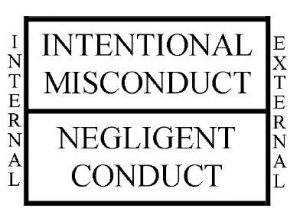Editor’s note: This article is part of a series. Click here for the previous article.
Gordon Graham here again. Thanks for reading these brief articles on how a full understanding of “real” risk management can positively impact your police department operations. In the last article, I started a discussion on family five of the 10 Families of Risk—Operational Risk Management—and laid out my thoughts on why things occasionally go wrong in police department operations.
Here is the graphic that I used in that piece:
We started off with the upper-right side of this chart: external intentional misconduct. One example of this is the use of “momentum weapons” (heavy trucks, etc.) by terrorists. Superintendent Ken Pennington from the Northern Ireland Police has studied this subject; I hope you were able to review his recent report.
Let’s move on to the bottom right portion of this chart.
Some of our problems come from external negligence. What is this all about? In the last article, I mentioned that another form of external intentional misconduct is arson: Terrorists can use wildland fires to cause the U.S. to spend massive amounts of money putting out those fires. In fact, ISIS suggests this tactic via the various websites that post the group’s writings trying to encourage bad people to do bad things to harm America and Americans.
But let me switch gears here for a second. Imagine a car filled with nuns traveling in the beautiful Adirondack Mountains. Admiring the majesty of the forest, they find a side road and pull over to enjoy a Diet Coke and the view. Sadly, in their nun training course they did not have a class on the dangers of parking a car in tall grass with a hot catalytic converter. This hot piece of metal (designed to generate cleaner air coming from the exhaust) ignites the grass. Thankfully, the nuns make their getaway on foot, but the car is burnt to a crisp and there is an ensuing massive wildland fire.
Can four nuns with no evil intent in their heart cause the same amount of damage as heavily trained ISIS members purposefully targeting their victims? The answer is yes—that is external negligence!
There are many forms of external negligence. How about the fellow with a hearing disability who, while remodeling his home, finds a firearm secreted in a wall? He has no evil intent, so he puts the gun in his car and heads toward the police station to drop it off. Little does he know this police department is on alert because of a threat to station personnel. The man gets out of his car carrying the gun. The cops see him coming and yell for him to drop the gun, but he does not hear them (remember, the man has a hearing disability). Many bad things can happen here, even though the man had no evil intent.
Can four nuns with no evil intent in their heart cause the same amount of damage as heavily trained ISIS members purposefully targeting their victims? The answer is yes—that is external negligence!
But one of the most common form of external negligence affecting public safety personnel is none of the above. Rather, it involves vehicle operations. Not a day goes by without some cop or firefighter someplace in America getting hurt or killed by a good citizen with no evil intent because that person was negligent in the operations of their personal car. Remember, this is not ISIS deliberately using a vehicle to run down a cop, but a good person (or perhaps an idiot or someone who should not be driving anymore) making a mistake—and the result is a dead or severely injured police officer or firefighter.
With this in mind, here are three control measures for you to consider.
First, please, please, please, regularly talk to your personnel about their role in safe driving. Topics to focus on include:
- The importance of being well-rested
- How to limit distractions (cell phones and in-car computers are a major distraction)
- The need to pay attention to surrounding traffic and watch out for the idiots and the inattentive
- Why they must always WEAR THEIR SEAT BELT
Please remember that one of the top causes of death in our profession—almost every year—is not being murdered (external intentional misconduct) but rather vehicle operations. Some of these tragedies are caused by external negligence: otherwise good people not driving correctly.
Second, wear your reflective vest when you are on some assignment involving standing in or near traffic. “Roadway incursions” are an identifiable risk and thus a manageable risk. I recognized early on in my career that one of the most dangerous things I did was being a pedestrian on or near any roadway. Directing traffic is filled with risk. Please do not fall into the trap of thinking it is not a big deal. Cars/trucks vs. pedestrian firefighters and cops is not a good mix and it can happen in the middle of the night or the middle of the day.
Now my guess is there is some wannabe “tactics expert” who will tell you, “Cops wear dark uniforms so they won’t be a target. A reflective vest is making me a target for some Ninja assassin and I refuse to be a target.” Well before you go off half-cocked on this issue, please take a look at the data. A cop is much, much more likely to be struck by passing traffic than taken out by an assassin on a rooftop. Having said this, there will be situations when we want to decrease our “visual conspicuity”—but that is why we need to hire smart people who understand when that is necessary.
Third, take advantage of the free training tools, resources and online classes available to you on this subject. Let me introduce you to a website run by a buddy of mine, Steve Austin. Now for you old folks reading this, not that Steve Austin (the Six Million Dollar Man). And for you slightly younger people, not that Steve Austin (of WWF or now WWE fame). No, Steven Austin the volunteer firefighter out of Cumberland County, Md. Steve coordinates the website www.respondersafety.com, which offers free online training and a wealth of resources to help you keep your personnel safe on the roadways. I use Steve’s material in my “tips of the day” and for other purposes—I like the way he looks at things.
In my next article, I want to move to the left side of the misconduct graphic and talk about the internal issues that we have so much more control over. But whether internal or external, the goal is the same: Address the identifiable risks to prevent problems prior to occurrence.





